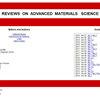具有可变孔隙率的热分层 MHD Powell-Eyring 纳米流体在经过拉伸的里加板时的熔化现象
IF 3.6
4区 材料科学
Q2 MATERIALS SCIENCE, MULTIDISCIPLINARY
引用次数: 0
摘要
最近,专家们对治疗镁缺乏引起的疾病特别感兴趣。低镁血症是由于血液中的镁不足而产生的,它是对不同疾病的额外刺激,如呕吐、嗜睡、恶心、食欲不振等。为了弥补这种不足,镁以纳米粒子的形式注入血液(基础液)中。这些镁纳米粒子的特性,特别是其尺寸、分散性和表面特性,对于优化其生物利用度和疗效至关重要。先进的材料表征技术可确保这些纳米粒子在生理环境中的稳定性和更佳性能。基于这些应用,目前的研究旨在通过在停滞点区域被线性可拉伸片材扭曲的 Powell-Eyring 纳米流体流动来解决镁缺乏问题。线性热分层、粘性耗散和焦耳加热用于揭示热传输特征。以 α 角向纳米流体施加磁场可进一步控制流体动力学和纳米粒子行为。利用变换建立一组无量纲控制方程。对比图用于解释温度场和速度场的物理行为,展示材料特性如何影响流体动力学。著名的收敛法(同调分析法)用于通过比较图形来求解模型。本文章由计算机程序翻译,如有差异,请以英文原文为准。
Melting phenomenon of thermally stratified MHD Powell–Eyring nanofluid with variable porosity past a stretching Riga plate
Recently, experts have become particularly interested in the treatment of disorders caused by magnesium shortage. Hypomagnesemia is produced by a magnesium deficit in the blood, which is an additional stimulation for different diseases such as vomiting, drowsiness, nausea, loss of appetite, and so on. To compensate for this shortage, magnesium is injected as a nanoparticle in the blood (base fluid). The properties of these magnesium nanoparticles specifically their size, dispersion, and surface characteristics are crucial for optimizing their bioavailability and therapeutic efficacy. Advanced material characterization techniques ensure the stability and enhanced performance of these nanoparticles in the physiological environment. Based on these applications, the current research aims to address magnesium deficiency via Powell–Eyring nanofluid flow distorted by the linearly stretchable sheet in the region of the stagnation point. Linear thermal stratification, viscous dissipation, and Joule heating are used to reveal the heat transport features. The magnetic field is applied to the nanofluid at an angle α to further control the fluid dynamics and nanoparticle behavior. Transformations are used to create a set of dimensionless governing equations. Comparative graphs are used to explain the physical behaviors of temperature and velocity fields, demonstrating how material properties impact fluid dynamics. The well-known convergence method (homotopy analysis method) is used to solve the model by comparing graphs.
求助全文
通过发布文献求助,成功后即可免费获取论文全文。
去求助
来源期刊

Reviews on Advanced Materials Science
工程技术-材料科学:综合
CiteScore
5.10
自引率
11.10%
发文量
43
审稿时长
3.5 months
期刊介绍:
Reviews on Advanced Materials Science is a fully peer-reviewed, open access, electronic journal that publishes significant, original and relevant works in the area of theoretical and experimental studies of advanced materials. The journal provides the readers with free, instant, and permanent access to all content worldwide; and the authors with extensive promotion of published articles, long-time preservation, language-correction services, no space constraints and immediate publication.
Reviews on Advanced Materials Science is listed inter alia by Clarivate Analytics (formerly Thomson Reuters) - Current Contents/Physical, Chemical, and Earth Sciences (CC/PC&ES), JCR and SCIE. Our standard policy requires each paper to be reviewed by at least two Referees and the peer-review process is single-blind.
 求助内容:
求助内容: 应助结果提醒方式:
应助结果提醒方式:


